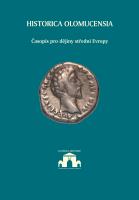The Moravian Pact of 1905: A Model Solution to Ethnic Conflict, or a Way to Deepen Ethnic Conflict in Multi-Ethnic Towns?
The Moravian Pact of 1905: A Model Solution to Ethnic Conflict, or a Way to Deepen Ethnic Conflict in Multi-Ethnic Towns?
A Case Study of Olomouc
Author(s): Andrea PokludováSubject(s): Local History / Microhistory, Social history, Pre-WW I & WW I (1900 -1919)
Published by: Univerzita Palackého v Olomouci
Keywords: Moravian Pact 1905; Olomouc; Nationalism; Everyday life;
Summary/Abstract: The study deals with the issue of the Moravian Pact (1905) with the example of the city of Olomouc. In the collective memory, Olomouc ranks among Moravian cities with a conflicting coexistence of Czech and German populations at the turn of the twentieth century. The aim of the study was to answer the question of whether the conclusion of the Moravian Pact (1905), which was considered to be a political reconciliation between the Moravian Germans and the Czechs, also led to the overcoming of animosity between the Czech and German population of the city in Olomouc. The choice of Olomouc was not accidental, as: 1. it was an alternative political centre to Brno – the provincial capital, 2. it was a city with a traditionally bilingual population and 3. the city became a centre of Czech and German activists concentrated in organisations such as National Union for East Moravia and Germans in Northern Moravia. In the introductory part of the study, the conflict zones of Czech-German coexistence are presented in detail, i.e. education, local economic life, municipal politics and elections to the Land Diet. Then, on a micro historical level, topics related to the political convention of Moravian Germans and Czechs from 1905, i.e. the Moravian Pact, are elaborated. Specific areas on which the Moravian Pact no longer had such an impact are listed, such as the fight for a child, as the intense activity of Czech activists partially resolved it before the lex Perek came into force. The impact of land elections and the national composition of city officials and civic service are described. There are two basic spheres in which animosity continued to deepen even after the Moravian Pact, namely municipal politics and the local economy. Life in Olomouc on the eve of the Great War did not take place under the sign of the national status quo, but in an atmosphere of persistent friction between Czech and German activists, which was transferred to the everyday life of the city’s population. In the end, the consequences led to the fact that the inhabitants were not nationally indifferent, but divided on the national principle into Czechs and Germans. Bilingualism persisted, however, in the communication practice of the population.
Journal: Historica Olomucensia: Journal for Central European History
- Issue Year: 64/2023
- Issue No: 1
- Page Range: 51-71
- Page Count: 21
- Language: English

